Physician assistants often do not learn about their future profession until they are already in college — or even afterwards, according to a pilot study led by Steven “Tony” Skaggs, PA-C, assistant professor and associate chair of the Department of Physician Assistant Studies.
That study is the subject of an article ― “Path to a Profession: How a Physician Assistant Becomes a Physician Assistant” — published in June by the Journal of Allied Health. Students in the Department of Physician Assistant Studies who have since graduated worked on the study alongside Skaggs, who is the study’s principal investigator. Five are coauthors of the article.
The study aims to illuminate the paths that lead PAs to the profession. Taking a phenomenological, qualitative approach, researchers interviewed eight PAs actively practicing in South Texas to learn how they chose the profession and what keeps them practicing. The interviews revealed four common experiences among the subjects: an unfamiliarity with the profession in the first two decades of life, a decision to pursue the profession as an undergraduate, confusion among patients about the difference between a PA and a medical doctor and significant work satisfaction.
“People who are in the profession usually find out about it later,” Skaggs said. “Every 8-year-old knows what a doctor is, every 8-year-old knows what a nurse is, but very few of these individuals understood was a PA was until their late second or third decade of life.”
The article shares the origins of the PA profession in the U.S. more than 50 years ago as a way to address a shortage of primary care providers, particularly in underserved and rural communities. The results of the pilot study suggest that additional study is warranted to confirm the late awareness of the PA profession. According to the article, the next steps include evaluating the understanding of the kindergarten through 12th-grade population about health care professions, including the PA profession. The authors suggest future research ensure diversity among research subjects so that outreach about the profession can be tailored to underrepresented groups.
Skaggs’ coauthors are graduates of the Master of Physician Assistant Studies program at the School of Health Professions. They include Madison Ashley, MPAS, PA-C, John Bojanski, MPAS, PA-C, Elise Path, MPAS, PA-C, Christina Russell, MPAS, PA-C, and Courtney Shaw, MPAS, PA-C.


